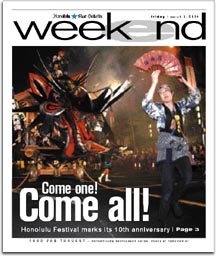
[ WEEKEND ]
COURTESY OF THE HONOLULU FESTIVAL
Mikoshi on parade
Nelson Fujio is known as "Parade Man," and with good reason. As parade director for this year's 10th annual Honolulu Festival Grand Parade, he's plenty busy leading up to this weekend's festivities, with what promises to be the biggest he's ever tackled in the festival's history.
More than 6,000 performers will be taking part in the truly Grand Parade, 39 of them students from Kamehameha Schools' Maui campus, winners of what festival officials hope will be an annual competition in the mikoshi design contest.
The 10th-graders won with "a very nice, simple and subtle design," Fujio said, "a very Maui design -- a humpback whale jumping out of the water.
"Most Japanese people would recognize the mikoshi as a shrine, offering up prayers for a good harvest, good fishing, anything that worships the main staples of man. With Hawaii, it could be anything, like fish, or taro. And there are all different types -- some you carry, others you pull like floats."
One local returning entry is a pineapple balloon mikoshi. Other favorites returning with the Japanese entourage are a giant rice barrel from Aizu Bange, spinning lanterns from Akita province and the parade-ending fire-spitting dragon from Omuta Daijayama Matsuri in the Fukuoka province.
COURTESY OF THE HONOLULU FESTIVAL
On the cover: Fire-spitting dragon.
The spinning lanterns will be hung from six 52-foot tall bamboo poles (each weighing 110 pounds) that will be balanced on the palms, foreheads, shoulders and hips of their carriers.
In addition to the Maui students' whale mikoshi, other new entrants Fujio describes are a 150-foot helium dragon balloon from Saitama, just north of Tokyo, and the Hita City Giom from Kumamoto prefecture. The float, more than 40 feet tall, is intricately designed with images of daily village life, with a theme based on ancient Chinese and Japanese folklore and kabuki performance scenes.
Rounding out the new entrants will be the Kanto Tobishoku Rengokai and Kanto Rengo Wakatobikai, professionals trained to work on high-rise buildings. They'll be showing off their gravity-defying skills and tricks on ladders throughout the parade. Combine that with other performance groups from Japan, and local high school bands, and Fujio said that adds up to 83 units for a parade lasting about three-and-a-half hours.
FL MORRIS / FMORRIS@STAR-BULLETIN.COM
Roy Matsumoto poses next to the whale he sculpted that will be placed on top of the Maui "mikoshi," which will be carried in the Honolulu Festival parade.
"PARADE MAN" has been in the business for 28 years, and when Fujio was approached 11 years ago by the Honolulu Festival originators, he suggested that the parade itself could be the centerpiece of the entire festival.
"Sometimes, in business, it's easier to hire people who have no previous experience, and that's how it went with this festival," he said. "There was no one to compete with, and we just did our own thing, and created our own image. We had so many spectacular things to offer to the people of Hawaii, and the festival continues to get better and better.
"It takes at least a year in advance to plan each festival. I try to keep it about the same every year, but because of the 10th anniversary, we decided to make it a big celebration. In fact, some of the Japanese groups that have participated have become recognized as national treasures in Japan. So interest has really grown, and it's become a big signature event for the Japanese.
"About 42 prefectures are going to be part of this year's festival," Fujio said. "For the people who live in Japan, the only time they can see so many of these participants in one place is to come to our festival."
Click for online
calendars and events.




